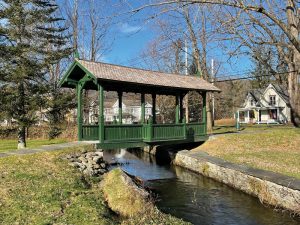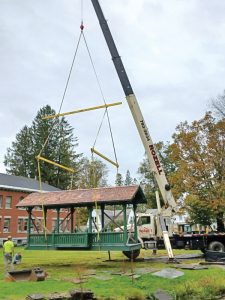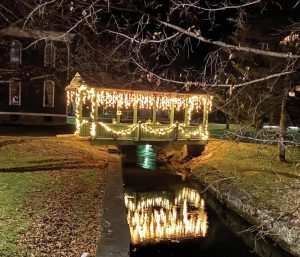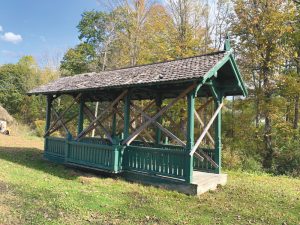Home to less than 2,000 residents, the quaint Village of Cambridge, NY, lies between the foothills of the Adirondack Mountains of upstate New York and the Green Mountains of Vermont. About 150 years ago, Cambridge was home to the Jerome B. Rice Seed Company, the second-largest seed company in America at that time, with clients throughout New England and the Eastern Seaboard.

The Rice Company started in the early 1800s when R. Niles Rice traveled throughout the country and sold his seeds from the back of a horse-drawn wagon. His business was very successful, and his son Jerome B. Rice began a construction campaign between 1879 and 1895 to erect several buildings for warehousing and distribution of the company’s seeds. The Rice Seed Company chose the least expensive real estate in Cambridge – a swamp, which was drained to become the site of its buildings. The access road to the property was unpaved and crossed Blair’s Brook (now called Owl Kill). Needless to say, the road was often a muddy mess, especially in the spring when the snow melted, and Jerome did not want his nearly 200 employees getting themselves (and his buildings) dirty as they walked to work.
Rice hired local architect Florans Hoxie to design and construct a covered pedestrian bridge across the stream so his workers could stay dry and clean. Hoxie built the bridge in his front yard, then disassembled it and hauled it by horse-drawn wagon to the site, where he reassembled it. The bridge is a relatively modest structure, about 23-feet long by about 6-feet wide, with three stringers and four heavy-timber portals framed with traditional heavy-timber joinery. Still, Hoxie incorporated several Victorian details into the bridge, including two sitting benches at midspan, where workers could stop and enjoy the views and sounds of the stream below.
Although the Rice Seed Company no longer exists, the former Rice Seed Company buildings are home to dozens of small companies, including professional offices, artists’ studios, and small-scale manufacturing. Many employees of these companies lived in the Village and walked across the bridge daily as they went to and from work, and it was a common sight to see residents relaxing on the sitting benches. Since its construction, the Green Bridge (as it is known locally) has been the defining streetscape feature for the Village’s Main Street. It is even pictured on postcards from the 1930s.
The bridge, however, was nearly lost about 10 years ago. The stone walls lining the stream were in poor condition, and a portion of the wall that supported the south end of the bridge collapsed. Thankfully, the bridge did not fall into the stream or sustain any damage, and it remained open to the public. In 2012, the Cambridge Valley Community Development and Preservation Partnership, a nonprofit community development corporation that facilitates downtown revitalization projects, asked the author to explore the feasibility of rehabilitating the bridge. Unfortunately, the property owner at that time was not at all interested in the bridge, and the feasibility study was never completed. The property was later sold to 17 Mile VARAK Park, LLC, and the new owners wholeheartedly embraced the idea of saving the bridge. Fearing for the public’s safety and the bridge itself, the owners donated the bridge to the Village of Cambridge, hoping it could be restored. In 2017, the bridge was removed and transported to the grounds of the Village Department of Public Works, where it sat in obscurity for the next couple of years. Village residents thought the bridge was gone for good, and the National Society for the Preservation of Covered Bridges website simply stated that the bridge was “GONE.” Interesting Fact: The New York State Covered Bridge Society does not consider this bridge an authentic covered bridge because it does not have trusses, even though it is thought to be the oldest surviving covered pedestrian bridge in America.
After the bridge was moved off-site, the Community Partnership collaborated with the Homefront Development Corporation, another nonprofit organization that assists communities with revitalization projects, to apply to the New York State Office of Homes and Community Renewal for a Main Street Grant to rehabilitate the bridge. Unfortunately, the grant was denied, but the members of the Community Partnership never lost hope; they tried again in 2019 and obtained a grant for $15,000.

The bridge remains a beloved piece of local history. A purposeful effort was made to involve as many people as possible in its rehabilitation, and regular social media posts were critical to engaging the community. In short order, a team of volunteers was assembled, including the Architect of Record (Jeff Goldstone of Goldstone Architecture) and the author, both of whom live in the Village. Construction documents were prepared as three separate contracts – one for the new substructures, one for the rehabilitation of the bridge, and one for its return across the stream. A condition of the grant was that the bridge had to be open to the public by the end of 2021. It seems that $15,000 does not buy much in the construction world today, but it was hoped that at least the bridge could be relocated onto new abutments for the dollar value of the grant, even if the bridge was not rehabilitated due to lack of funds.
While the bridge itself is public property owned by the Village, the land, including the stone walls lining the stream, is privately owned by 17 Mile VARAK Park. Eventually, the owners of the Park want to donate the grounds adjacent to the bridge to the Village, but the current condition of the stone walls precludes that. Repairing the stone walls is not a realistic option, as this would be prohibitively expensive. Instead, new concrete abutments were designed to fit within the confines of the existing stone walls that line the stream, even though one of those walls is now partially collapsed. Plans are being prepared to return the Owl Kill to a natural meandering stream, and the siting of the new abutments relative to the existing walls was carefully considered to accommodate that.
A contract was awarded to Dave Clark Excavation in early 2021. Clark said he wanted to “do something for the community” and agreed to complete all contracts for significantly less than the dollar value of the grant. Since the bridge was stored off-site, it could be rehabilitated without concern for impact to the stream, significantly reducing the time, effort, and cost to complete the work. Thankfully, the basic structure of the bridge was sound. The three floor beams were replaced about 25 years ago, but everything else was original. Deteriorated wood framing, generally limited to the railings and roof boards, was replaced in kind, and the bridge was repainted. The most extensive single effort in the rehabilitation of the bridge was replacing the cedar shingles. The Community Partnership purchased new cedar shingles for $4,500, and they were finish-cut by members who then handed them over to the Contractor for installation.

While completing the repairs to the bridge itself, the Contractor prepared the site for the new abutments. Work within the stream was regulated by the New York State Department of Environmental Conservation, with stipulations on maintaining water clarity and protecting the fish in the stream. The Contractor precast both abutments off-site to limit the time and extent of work within the stream and install them with minimal effort. The bridge was raised by about one foot to increase the freeboard in anticipation of the stream channel being naturalized.
After four years in storage, the bridge was finally set on its new abutments in September, but something did not seem quite right – the bridge sagged by a few inches and it vibrated whenever anyone walked across it. The distance between the stone walls lining the stream was much shorter than the bridge’s overall length, meaning that the bridge was cantilevered over the stone walls by a couple of feet on each side. Probably for the first time in its 130-year history, the bridge was spanning its full length, and the stringers, while adequate to carry the dead and live loads, deflected noticeably. The Contractor temporarily jacked the bridge to as close to level as possible and installed engineered lumber beams alongside the existing stringers. The bridge remained relatively level when the jacks were removed, and the vibrational characteristics were significantly improved.
In late 2021, the bridge was opened to the public, and it quickly became the place to be. A local history buff (who also directed the social media campaign) and the local chapter of the Knights of Columbus decorated the bridge with Christmas lights powered by an electrical cord run through a window of a tenant of the Park. The history buff even brought students from the 4th-grade class to light the bridge in a touching ceremony. Almost overnight, the refurbished bridge became a media sensation – many were spotted photographing the bridge, families used the bridge as a background for Christmas photos, and at least one marriage proposal took place on the bridge. (She said yes.)
The bridge’s rightful repair and return is an example of what can be accomplished when a community rallies together for a good cause. A word of caution, however. Community projects like these can take several years from conception to completion, especially when design and construction services are donated pro-bono and the project is small. In fact, talk of refurbishing the bridge began almost 10 years ago, and it took about eight years of start-and-stop before a grant was awarded. At times it seemed the Green Bridge would be lost forever. Instead, the little bridge was saved through perseverance, collaboration, and deliberate community engagement. Architectural, structural engineering, and landscape design services were donated. The truck used to haul the bridge from the Village DPW yard and the crane used to set the bridge were also donated. The Contractor donated significant labor, clearly spending several times the value of the grant to complete the work. Even the Christmas lights and the electricity to power them were donated. The adage many hands make for light work certainly was true for this project.

It is the author’s conviction that all engineers should give back to their communities in some way. Indeed, the Code of Ethics of the American Society of Civil Engineers states that “engineers (shall) enhance the quality of life for humanity” (Ethical Responsibility, Section I.b) and (shall) “endeavor to be of service in civic affairs” (Ethical Responsibility, Section I.e). As this project demonstrates, just a little bit of engineering effort significantly enhanced the quality of life for many of the Village’s residents.■
Project Team
Owner: Village of Cambridge, NY
Structural Engineer: EYP, Inc., Albany, NY
Architect: Goldstone Architecture, Bennington, VT
Contractor: Dave Clark Excavation, Cambridge, NY
